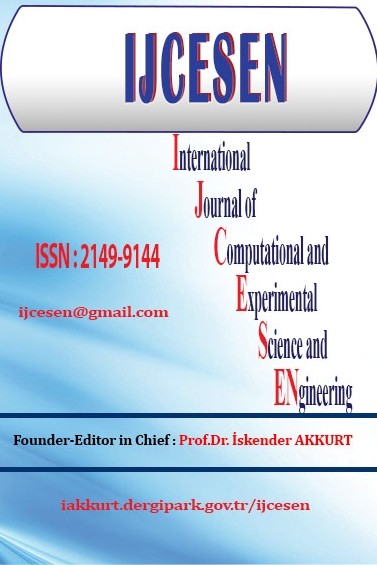Comparing the Effect of Process Fluid for Wet Ground Heat Exchanger
Comparing the Effect of Process Fluid for Wet Ground Heat Exchanger
___
- [1] K.K. Agrawal, R. Misra, G. Das Agrawal, "Improving the thermal performance of ground air heat exchanger system using sand-bentonite (in dry and wet condition) as backfilling material", Renew. Energy. 146 (2020) 2008–2023. doi:10.1016/j.renene.2019.08.044.
- [2] K.K. Agrawal, R. Misra, G. Das Agrawal, "To study the effect of different parameters on the thermal performance of ground-air heat exchanger system: In situ measurement", Renew. Energy. 146 (2020) 2070–2083. doi:10.1016/j.renene.2019.08.065.
- [3] J. Lin, H. Nowamooz, S. Braymand, P. Wolff, C. Fond, "Impact of soil moisture on the long-term energy performance of an earth-air heat exchanger system", Renew. Energy. (2018) 1–12. doi:10.1016/j.renene.2018.06.106.
- [4] M. Cuny, J. Lin, M. Siroux, C. Fond, "Influence of rainfall events on the energy performance of an earth-air heat exchanger embedded in a multilayered soil", Renew. Energy. (2019) 1–12. doi:10.1016/j.renene.2019.01.071.
- [5] R. Misra, S. Jakhar, K.K. Agrawal, S. Sharma, D.K. Jamuwa, M.S. Soni, G. Das Agrawal, "Field investigations to determine the thermal performance of earth air tunnel heat exchanger with dry and wet soil: Energy and exergetic analysis", Energy Build. 171 (2018) 107–115. doi:10.1016/j.enbuild.2018.04.026.
- [6] D. Belatrache, S. Bentouba, M. Bourouis, "Numerical analysis of earth air heat exchangers at operating conditions in arid climates", Int. J. Hydrogen Energy. 42 (2017) 8898–8904. doi:10.1016/j.ijhydene.2016.08.221.
- [7] G. Gan, "A numerical methodology for comprehensive assessment of the dynamic thermal performance of horizontal ground heat exchangers", Therm. Sci. Eng. Prog. 11 (2019) 365–379. doi:10.1016/j.tsep.2019.04.013.
- [8] H. Li, L. Ni, Y. Yao, C. Sun, "Experimental investigation on the cooling performance of an Earth to Air Heat Exchanger (EAHE) equipped with an irrigation system to adjust soil moisture", Energy Build. 196 (2019) 280–292. doi:10.1016/j.enbuild.2019.05.007.
- [9] K.T. Papakostas, A. Tsamitros, G. Martinopoulos, "Validation of modified one-dimensional models simulating the thermal behavior of earth-to-air heat exchangers—Comparative analysis of modelling and experimental results", Geothermics. 82 (2019) 1–6. doi:10.1016/j.geothermics.2019.05.013.
- [10] M. Habibi, A. Hakkaki-Fard, "Evaluation and improvement of the thermal performance of different types of horizontal ground heat exchangers based on techno-economic analysis", Energy Convers. Manag. 171 (2018) 1177–1192. doi:10.1016/j.enconman.2018.06.070.
- [11] U. Durmaz, M. Ozdemir, "An experimental study on the soil-based natural cooling", Int. J. Environ. Sci. Technol. 16 (2019) 1–4. doi:10.1007/s13762-018-1691-1.
- [12] U. Durmaz, O. Yalçınkaya, "Experimental investigation on the ground heat exchanger with air fluid", Int. J. Environ. Sci. Technol. (2019) 1–6. doi:10.1007/s13762-019-02205-w.
- [13] Y. Nam, H.-B. Chae, "Numerical simulation for the optimum design of ground source heat pump system using building foundation as horizontal heat exchanger", Energy. 73 (2014) 933–942. doi:10.1016/j.energy.2014.06.108.
- Yayın Aralığı: 4
- Başlangıç: 2015
- Yayıncı: Prof.Dr. İskender Akkurt
Comparing the Effect of Process Fluid for Wet Ground Heat Exchanger
The Effect of Exhaust Temperature on Urea-Water Decomposition in Marine SCR Systems
Kubilay BAYRAMOĞLU, Güner ÖZMEN, A. Güldem CERİT
Recycling and Characterization of Metallic Chips Using Powder Metallurgy
Handan DEMİREL, Aydın GÜNEŞ, Ömer Sinan ŞAHİN
Determination of the Radiation Dose Level in Different Slice Computerized Tomography
Osman GÜNAY, Özcan GÜNDOĞDU, Mustafa DEMİR, Mohammad ABUQBEİTAH, Doğan YAŞAR, Serpil AKÖZCAN, Enis KAPDAN, Onur YARAR
Yonca Yahşi ÇELEN, Hazım Orhan KIZILKAYA
Xuedong SHİ, Xiang’an YUE, Mingda DONG, Changchun YANG
Vibration Behavior of Composite Materials Produced by Waste Metal Recycling
Aydın GÜNEŞ, Erdi GÜLBAHÇE, Emin SALUR, Abdullah ASLAN, Ömer Sinan ŞAHİN
Yonca YAHŞİ ÇELEN, Hazım Orhan KIZILKAYA
Optimization of Air Distribution in A Non-Ducted Concealed Type Fancoil Unit Heat Exchanger
Murat OZSOY, Canberk YUCEL, Onur VARLICA, Serhan KILIÇ, Kagan KAPLAN
